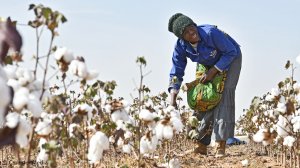Local cotton lint buying driving clothing and textile industry’s revitalisation




Commercial cotton farm in Marble Hall, Limpopo
Photo by Creamer Media's Dylan Slater
Loskop ginnery, in Limpopo
Photo by Creamer Media's Dylan Slater
Clothing retailer Edcon has increased its order for cotton lint to 2 200 t for the next year as part of its commitment to the clothing and textile industry through the Sustainable Cotton Cluster (SCC).
Edcon first bought 600 t of cotton lint in mid-2016 when it signed a cotton lint commitment with the South African Sustainable Textile Apparel Cluster (Sastac).
The retailer group increased its demand to 1 600 t and then to 1 757 t in mid-2018.
The cotton lint commitment has enabled cotton ginners to pay farmers when they deliver cotton; cotton ginners to accommodate terms required by spinners and the rest of the value chain; cotton farmers and ginners to use their assets as security for finance; and cotton farmers and ginners to align themselves with lint demand.
Edcon’s Jet and Edgars subsidiaries use cotton lint to manufacture men’s chinos and t-shirts, as well as towels.
Edcon has since become one of three retailers, including Woolworths and Mr Price, to form part of SCC.
SCC brings together the entire cotton value chain, including the public sector, organised labour, consumer organisations, service providers and dedicated cluster management. The cotton value chain includes farmers, ginners, spinners, fabric manufacturers, fabric processors, clothing manufacturers and retailers.
SCC ensures the entire cotton value chain is kept in South Africa, from the farmer to the retailer.
SCC functions as a programme of industry association Cotton South Africa (Cotton SA) and was established alongside Sastac in 2014 to serve cotton-specific interventions.
Sastac was established with R200-million funding support from the Department of Trade and Industry to revive South Africa’s clothing and textile industry.
The funding supported a five-year plan from 2015 to 2019 to accelerate growth and development of the cotton industry. The plan helped the industry to create between 7 000 and 8 000 jobs so far, and has assisted in forming 600 new small, medium-sized and microenterprises.
Cotton SA CEO Hennie Bruwer explained during a cotton farm visit in Limpopo, attended by Engineering News Online, that the clothing and textile industry in 2013 produced a record low 5 000 t of cotton lint, leading to South Africa importing 95% of its cotton.
He noted that that was sad considering that the country’s clothing and textile industry had been the second-largest employer in the country during the 1980s – second only to the gold mining industry.
The clothing industry had, since 2013, increased output to producing around 50 000 t/y of cotton lint, with the help of about 1 600 black emerging farmers growing cotton on 6 000 ha of clothing- and textile-focused farms.
However, production still falls short of meeting South Africa’s cotton lint consumption of around 315 000 t/y.
The industry is targeting output of 60 000 t/y of cotton lint by 2020.
Ginnery Loskop Cotton CEO Joseph Kemp said that there was more than 65 000 ha of land around the Marble Hall area in Limpopo that was ideal for cotton farming.
However, emerging farmers struggle to secure financing. He noted that if more private sector companies such as Edcon were to sign orders for cotton lint, then that could serve as security for financing.
Meanwhile, Edcon committed to continuously increasing its use of local materials to manufacture clothing and further support the SCC.
Edcon CEO Mike Elliot pointed out that Edcon had increased its use of local materials to 53% over the last few years.
Bruwer noted that the industry needed more investment in harvesting, spinning and weaving technologies.
If South Africa increased its local beneficiation of cotton to a level where it can do import substitution of 50% on four basic retail items – t-shirts, towels, chinos and underwear – it could create more than 75 000 jobs in the industry, and inject nearly R10-billion into the economy.
Article Enquiry
Email Article
Save Article
Feedback
To advertise email advertising@creamermedia.co.za or click here
Comments
Press Office
Announcements
What's On
Subscribe to improve your user experience...
Option 1 (equivalent of R125 a month):
Receive a weekly copy of Creamer Media's Engineering News & Mining Weekly magazine
(print copy for those in South Africa and e-magazine for those outside of South Africa)
Receive daily email newsletters
Access to full search results
Access archive of magazine back copies
Access to Projects in Progress
Access to ONE Research Report of your choice in PDF format
Option 2 (equivalent of R375 a month):
All benefits from Option 1
PLUS
Access to Creamer Media's Research Channel Africa for ALL Research Reports, in PDF format, on various industrial and mining sectors
including Electricity; Water; Energy Transition; Hydrogen; Roads, Rail and Ports; Coal; Gold; Platinum; Battery Metals; etc.
Already a subscriber?
Forgotten your password?
Receive weekly copy of Creamer Media's Engineering News & Mining Weekly magazine (print copy for those in South Africa and e-magazine for those outside of South Africa)
➕
Recieve daily email newsletters
➕
Access to full search results
➕
Access archive of magazine back copies
➕
Access to Projects in Progress
➕
Access to ONE Research Report of your choice in PDF format
RESEARCH CHANNEL AFRICA
R4500 (equivalent of R375 a month)
SUBSCRIBEAll benefits from Option 1
➕
Access to Creamer Media's Research Channel Africa for ALL Research Reports on various industrial and mining sectors, in PDF format, including on:
Electricity
➕
Water
➕
Energy Transition
➕
Hydrogen
➕
Roads, Rail and Ports
➕
Coal
➕
Gold
➕
Platinum
➕
Battery Metals
➕
etc.
Receive all benefits from Option 1 or Option 2 delivered to numerous people at your company
➕
Multiple User names and Passwords for simultaneous log-ins
➕
Intranet integration access to all in your organisation



















